
6 Reasons Why You Must Visit the Fossil Hall at the National Museum of Natural History
Don’t miss the ‘deep time’ exhibit, an absolute marvel to behold that’s free to visit and perfect for the whole family..
The Smithsonian National Museum of Natural History 's David H. Koch Hall of Fossils is a $110 million, 31,000-square-foot exhibit with a theme of Deep Time , borrowed from a scientific phrase that illustrates how Earth’s history has played out over billions of years – what we think of as history is just a small fraction of our planet’s past.
Prepare to be amazed, overwhelmed, engaged and dazzled. Read on for more reasons why you can’t miss this stunning adventure through Earth’s scientific and biological history.
You will journey back billions of years
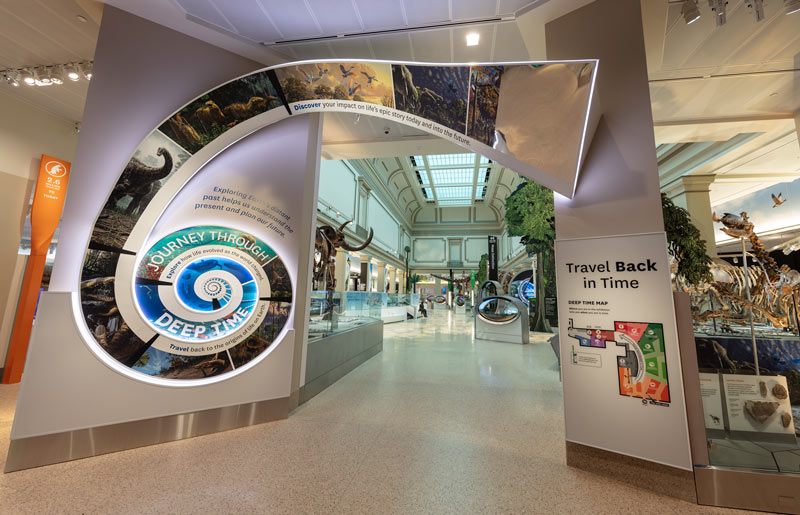
Deep Time exhibit at the Smithsonian National Museum of Natural History - Free museum exhibit in Washington, DC
Throughout its expanse, Deep Time reflects themes of connection, evolution, extinction and climate change. The experience encapsulates billions of years of science, summarizing numerous time periods through impressive fossil specimens, informative text, dioramas, murals, videos, interactive touchscreens and touchable objects.
Most visitors will begin their journey from the museum’s rotunda, with the first major encounter coming with an American mastodon dated roughly 15,500-11,500 years ago (known as the Quaternary period). From there, the wonder never ceases – you’ll traverse the age of dinosaurs (where you’ll see a 67 million-year old T. rex preparing to eat a fallen Triceratops ), learn about past mass extinctions and their resounding effects, see the effects of climate change, witness the evolution of life from the oceans to ashore and so much more.
The fossil specimens on display are truly jaw-dropping
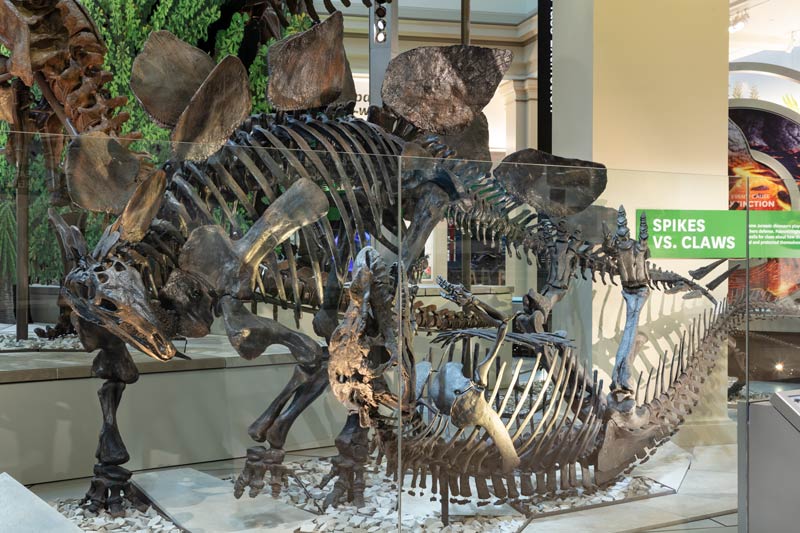
Deep Time features roughly 700 fossil specimens, many never displayed before. Aside from the previously mentioned T. Rex and the American mastodon, you can gaze at a woolly mammoth, a giant deer from 15,200-11,100 years ago, a giant sloth and the brontothere mammal, a fossil from Nebraska over 30 million years old and the oldest unchanged skeletal mount in the exhibit. We could keep going, but we don’t want to ruin any more momentous surprises.
Interactive videos and diagrams highlight important issues and share fascinating facts
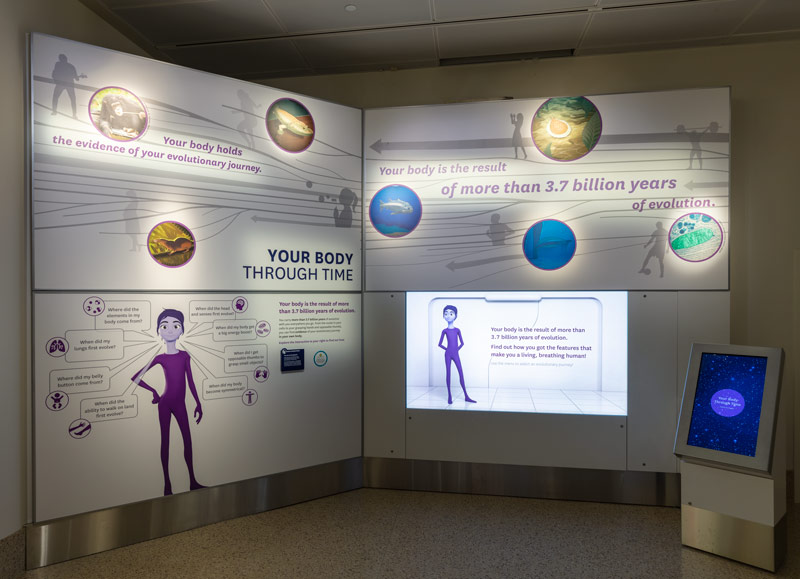
Interactive display at the Museum of Natural HIstory's Deep Time Exhibit - Free things to do in Washington, DC
In total, the new Fossil Hall offers 13 videos and eight interactive touchscreens, supplementing its incredible display of artifacts. The video “How Are We Changing The Planet?” shows just that, while “Earth’s Ancient Fever” shows similarities between the past and present and what ancient climate can tell us about the future. One touchscreen illuminates how people are addressing the issue of climate change; another, entitled “Your Body Through Time,” shows the gradual evolution of the human body, with each body part triggering a video that explains why the part became necessary. Technological elements will engage you and your mind throughout the exhibit.
Fossil Basecamp offers fun, hands-on activities
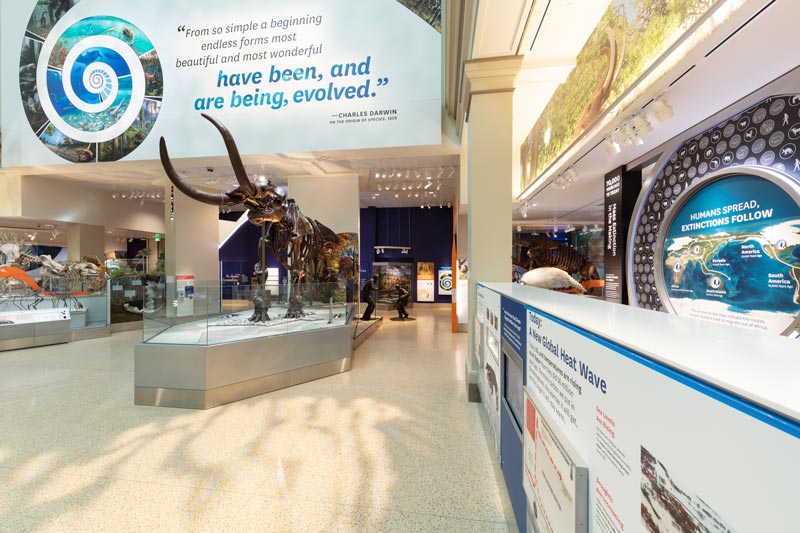
National Museum of Natural History
The Coralyn W. Whitney Fossil Basecamp is an interactive area that introduces important concepts and themes throughout Deep Time , inspired by the museum’s Q?rius learning space. Activities are facilitated and supervised by the museum staff, and both kid and adult visitors can participate and ask these staff members about their work at the museum. Demonstrations will feature touchable objects that will enlighten visitors on the topics of fossil dating, fossilization and evolution.
You can see how fossils are collected, prepared and stored at the FossiLab
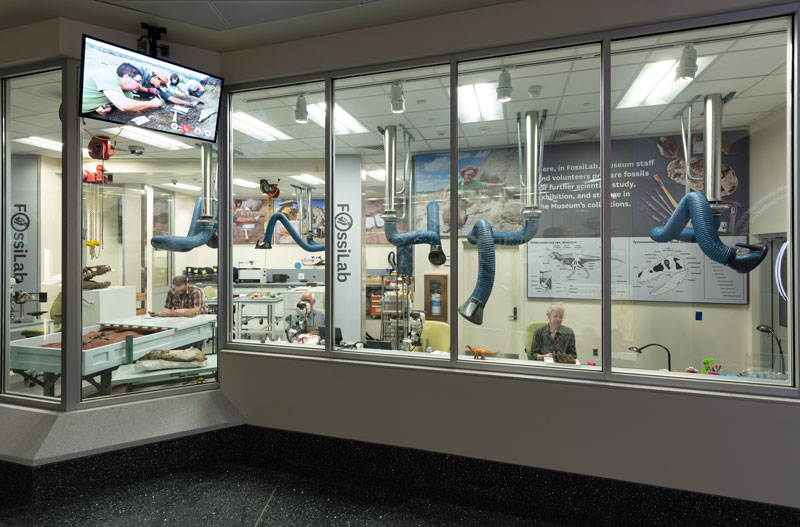
FossiLab at the Smithsonian National Museum of Natural History - Free museums in Washington, DC
Have you ever wondered how fossils end up on display in a museum? Deep Time ’s FossiLab provides incredible insight into the process. The space is populated by fossil preparators and museum volunteers, giving visitors the opportunity to see how fossils are preserved and prepped for scientific study and viewing in the museum.
Climate change, its impact and possible solutions are showcased in detail
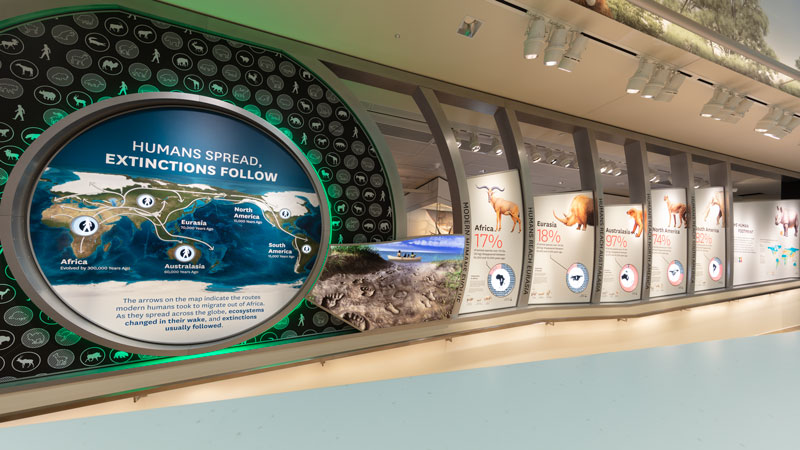
Both the Changing Climates section and the Age of Humans Gallery dive deep into the topic of climate change. The former explores the Paleocene-Eocene Thermal Maximum, an incredibly rapid global warming event that occurred 56 million years ago, and how it can help predict the effects of modern climate change. Changing Climates goes on to show how humans have accelerated a similar warming effect and what choices they can make to stop it. In Age of Humans, visitors are shown how people have launched unparalleled change on the planet over the last 10,000 years. A theater space details what our population is doing in response to the changing planet and a touchscreen shows how you can do your own part in this response through subjects and activities that you love.
More About DC
You may also like..
80+ Things to Do This May in Washington, DC
Free Things to Do: Theater & Performing Arts in Washington, DC
Things to Do This Week in Washington, DC
Smithsonian National Museum of Natural History Virtual Tour
Subscribe or renew today
Every print subscription comes with full digital access
Science News
The smithsonian’s ‘deep time’ exhibit gives dinosaurs new life.
Renovated fossil hall showcases ancient animals in their environments

PREHISTORIC SCENE The Smithsonian’s updated fossil hall displays snapshots of the past, such as this Diplodocus reaching out to feed from a tree.
Lucia Martino, Smithsonian Institution
Share this:
By Carolyn Gramling
June 4, 2019 at 12:17 pm
After five years, the Smithsonian National Museum of Natural History in Washington, D.C., is finally reopening its dinosaur hall on June 8. Visitors may come for fan favorites like Tyrannosaurus rex and Stegosaurus — and these fossils are gorgeously presented. But the new, permanent exhibition, the “ David H. Koch Hall of Fossils — Deep Time ,” has a much grander story to tell about the history of life on Earth, how organisms have interacted with each other for eons and how they’ve interacted with Earth and its climate.
Counterintuitively, the exhibition starts with humans.
Many exhibitions about the evolution of life tend to open with abstract concepts: the chemical formula for life or primordial microbes that lived in shallow seas. But the “Deep Time” designers wanted visitors to immediately feel their own part in the story, says exhibition project manager Siobhan Starrs. So the exhibition starts in the present and moves backward through time.
“The big, big starting point is that life is all connected, through billions of years of time,” she says. Scientists refer to that vastness of time on a geologic scale as deep time, a term suggesting a long, durable thread connecting the past to the present.

That sense of connectedness leads to another central theme: Putting life in context and moving beyond typical predator-prey scenes to give a better sense of the world in which creatures lived. Mixing fossils with other media, such as murals and statues, the exhibition depicts snapshots of life in the past. A woman gathers hickory nuts near a giant mastodon, while a saber-toothed tiger lurks nearby. A giant sloth with sheathed claws stretches up to snatch fruit from an orange tree. An Allosaurus curls its tail around a clutch of eggs.
“ David H. Koch Hall of Fossils — Deep Time ”
Opens june 8, smithsonian national museum of natural history | washington, d.c..
Not all of the scenes are so peaceful: A T. rex chomping on a Triceratops , placing one foot firmly on the prey’s back to hold it in place, is sure to be a crowd-pleaser. But even that scene, Starrs notes, is meant to convey a more subtle story. Nearby, a shallow pond contains turtles, clams and mussels. “Even the T. rex had a context; it didn’t live in isolation.”
Deeper in time, visitors come to the story of plant evolution and the great swamp forests of the Carboniferous Period, about 359 million to 299 million years ago. One stunning section simulates discoveries made within a coal mine, with fossils of giant trees embedded in the ceiling and walls.
Using deep time as a framing concept “allows us to tell a story about changing ecosystems and changing environments through time, and how they interact with one another,” says Scott Wing, the museum’s curator of paleobotany. Compared with previous ways of presenting the history of life, he says, “it’s a profound shift in how we think about ourselves, and how we think about the natural world around us.”
The new exhibition is a big step forward from the previous fossil hall in other ways. For example, “Deep Time” includes a tribute of sorts to its predecessor, with a vertically mounted fossil of a Stegosaurus that had been embedded for decades in the museum’s floor. Scientists excavated the Stegosaurus and disassembled other long-displayed fossils and were once again able to examine the bones closely.

That led to some surprises, says dinosaur curator Matthew Carrano. Two different species of Camptosaurus once on display turned out to be the same species, he says. A Triceratops skeleton turned out to be a “Frankenfossil,” a mix of bits that weren’t all from Triceratops .
The exhibition’s final area returns to the present and looks toward the future, exploring interactions between Earth’s changing climate and the planet’s life-forms, as well as how human actions might further alter climate. That casting forward is another thing that sets the new exhibition apart, Starrs says. The hope is that after experiencing the fossil hall, “the visitor is now thinking on a deep time scale,” she says: Not just how humans might currently be altering Earth’s climate but also what legacy people will leave behind thousands or even millions of years into the future.
More Stories from Science News on Science & Society

Rain Bosworth studies how deaf children experience the world

Separating science fact from fiction in Netflix’s ‘3 Body Problem’


Language models may miss signs of depression in Black people’s Facebook posts

Aimee Grant investigates the needs of autistic people

In ‘Get the Picture,’ science helps explore the meaning of art

What Science News saw during the solar eclipse

During the awe of totality, scientists studied our planet’s reactions

Your last-minute guide to the 2024 total solar eclipse
Subscribers, enter your e-mail address for full access to the Science News archives and digital editions.
Not a subscriber? Become one now .
When Whales Walked: Journeys in Deep Time
- Documentary
“You Are Here:” Deep Time at the Smithsonian

As an avid young reader, I devoured EL Konigsburg’s 1967 novel From the Mixed-Up Files of Mrs. Basil E. Frankweiler . I identified strongly with the protagonist (like many other readers, I suspect)—a smart, curious girl called Claudia who hatched a plan to run away from unappreciative parents and live in the Metropolitan Museum of Art. Claudia and her brother spent their nights exploring the museum, and I coveted their secret access to a treasure trove of knowledge.
Looking back, my fascination with museums has clearly played out in my doctoral research. My dissertation focuses on emerging relationships between humans and nonhumans under ecological emergency. Unsurprisingly, the natural history museum is one of the most fraught sites in which these relationships have historically been constructed.
In July 2019, I took a trip to the Hall of Fossils at the National Museum of Natural History at the Smithsonian Institute (I did not, however, sneak in and stay overnight). The David H. Koch Hall of Fossils—Deep Time reopened in June 2019 after a multiyear, multimillion dollar renovation project.
By reframing the Smithsonian’s extensive fossil collection with the concept of deep time , the museum aimed to draw connections between geological history and contemporary climate change. As such, it engages with the challenge of history in the Anthropocene , a challenge that Dipesh Chakrabarty described in his oft-cited article “The Climate of History: Four Theses” (2009). Chakrabarty argues that climate change shakes the foundations of historical inquiry, and that “the task of placing, historically, the crisis of climate change thus requires us to bring together intellectual formations that are somewhat in tension with each other: the planetary and the global; deep and recorded histories; species thinking and critiques of capital.” [1] These historiographical difficulties surface quite clearly in the new version of the Hall of Fossils, morphing from what once was a “ Hall of Extinct Monsters ” to a conceptual lens which places humans in the context of geological history.

One of the key questions I ask in my dissertation is whether traditional practices of display found in natural history museums can truly be used to combat climate change, particularly as they depend on articulating a separation between the subject who looks (human) and the object to be looked at (nonhuman). Much of the environmental destruction caused by global capitalism can be traced to this foundational division. New forms of relationality that dismantle Eurocentric and capitalist human exceptionalism are central to fighting against climate change and for climate justice.
So how can a hall of fossils, designed to display the remains of life from times long past for human edification, contribute to imagining these new relations? The new Fossil Hall invites visitors to travel backwards in time, from the most recent ice age to the beginnings of the planet. Scattered throughout the displays, small labels describe “Human Connections,” placing humanity at the moment of mastodon extinction and within the global food web.

These connections link evolutionary and geological history with human history through the idea that humanity is a global force of change. Though the dinosaur fossils remain the hall’s spectacular draw for visitors, the Age of Humans gallery attempts to link contemporary environmental change with human action—all in the context of Deep Time. The gallery features a series of five films showcasing different responses to climate change, from activism by native Hawaiians to preserve coral reefs to efforts to revitalize the oyster population native to New York’s Hudson Bay. These individual stories exemplify some of the ways humans are causing global change. The overarching story of Deep Time tries to show that, though the planet has undergone numerous changes over time, something about this era, with humans, is different.
The David H. Koch Hall of Fossils—Deep Time demonstrates the tensions between the work of display in knowledge production and imagining new ecological futures. In a hall named for one of the richest men in the world, who made his fortune at least partly from the wholesale destruction of the environment and use of fossil fuels, full of fossilized traces of extinct life and warnings of more extinction to come, what is offered as the way forward in the face of large-scale planetary changes? What roles do natural history museums have to play in working toward climate justice? Can human history be integrated into geological history to better understand how we got here? My sense is that radically different modes of engagement are needed to pursue ethical ecological relations, which might mean completely rethinking the work of natural history museums.
[1] Dipesh Chakrabarty, “The Climate of History: Four Theses,” Critical Inquiry 35 (2009): 213.
*Cover Image Credit: A panoramic view of the new David H. Koch Hall of Fossils—Deep Time at the National Museum of Natural History. Photo by author.
Share this:
- Click to share on Twitter (Opens in new window)
- Click to share on Facebook (Opens in new window)
- Click to email a link to a friend (Opens in new window)
Begin typing your search above and press return to search. Press Esc to cancel.
Open seven days a week.
10:00 a.m - 5:30 p.m., including holidays with the exception of December 25th when we are closed to the public.
10th St. & Constitution Ave. NW Washington, D.C. 20560
Visitors may enter from the National Mall on Madison Drive or Constitution Ave.
Admission is FREE.
Tickets are not required
Guidelines for Visiting
The Smithsonian is implementing COVID-19 safety measures based on guidance from the CDC and local governments. The latest guidelines are available at si.edu/visit/tips .
When is the museum open? The National Museum of Natural History is seven days a week from 10 a.m. to 5:30 p.m., except December 25.
Are masks still required? As of March 11, masks are not required to visit Smithsonian museums or the National Zoo. While it will not be required, all visitors who feel more comfortable wearing a face mask during their visit are encouraged to do so.
Are passes necessary to enter the museum? No, free timed-entry passes are no longer needed to enter the museum.
Will there be security screening? For everyone’s safety, all visitors are required to go through screening during the security process. One of our security personnel will conduct a thorough but hand-check of all bags, briefcases, purses, strollers, and containers. Please visit the Smithsonian’s security information page for more information on prohibited items.
All visitors are required to walk through a metal detector. Those unable to go through the metal detector will be hand-screened with an electronic wand by security personnel.
Protective safety shields have been installed at bag-check screening stations and register. We encourage visitors to limit the number of personal belongings and bags brought into the museum as they will be subject to a thorough search. Limiting the items brought will increase your speed through security checkpoints and help us all maintain a safe social distance. Please note that we do not offer coat, bag, or locker storage at this time.
Is a COVID-19 vaccine required? Visitors are not required to show proof of COVID-19 vaccination to enter the museum.
Will everything be open at NMNH? We will open as much as we determine it is safe to open, but some spaces will remain closed for now. Visitors should check the website for complete information about programs, learning venues, cafes, retail, and high-touch, interactive exhibits. The restrooms will be open. Limited locker storage is available for small bags and items.
Will the museum cafés and retail shops be open?
The Atrium Café is open from 11:30am-3:30pm and the Ocean Terrace Café is open 11:30am-4:00pm. The Family Store, Gallery Store, and Gems and Minerals Store are open from 10am-5:30pm.
Will guided tours, demonstrations, and events resume? Some in-person events have resumed.
Is there a coat or bag check at the museum? We have limited locker storage available for small bags and items. Visitors are encouraged to travel as lightly as possible and refrain from bringing large bags and packs for the best museum experience.
Are there family-friendly restrooms? A restroom designated for family use is located on the 1st floor of the museum, off of the Sant Ocean Hall.
Can I bring my stroller, scooter, walker, wheelchair or any type of mobility device? The museum is accessible to visitors using strollers, scooters, walkers, wheelchairs, and mobility devices. There are elevators available to visitors on every floor of the museum.
Are wheelchairs available? A very limited number of manual wheelchairs are available free of charge on a first-come, first-served basis for use while visiting the museum. You are encouraged to bring a wheelchair with you due to limited availability.
How do I contact the museum with questions? For more information about visiting the museum, please email [email protected] .
Masks are not currently required to visit. While not required, all visitors who feel more comfortable wearing a face mask during their visit are encouraged to do so.
Our current health and safety measures are based on guidance from the Centers for Disease Control and Prevention (CDC) and local governments. These measures may change in response to changing CDC COVID-19 Community Levels, so we encourage visitors to regularly check our website before their visit for the latest guidelines.
Museum Address The museum is located on Madison Dr. NW, between 9th St NW and 12 St NW ( Google Map ). Visitors may enter on Madison Ave. or at 10th St. NW & Constitution Ave. NW.
Metro The closest Metro stations to the museum are the Federal Triangle Metro station, located on the Blue, Orange, and Silver lines; the Archives/Navy Memorial station on the Green and Yellow lines; and the Metro Center station on the Red line. View a map of the closest Metro stations .
Parking There are no Smithsonian Institution public parking facilities on the National Mall. There are a number of nearby commercial lots and garages which may have available parking. If you must drive, please see parking options . For additional information on bus parking, contact the National Park Service Mall Operations Office at 202-426-6841 .
For More: Visit our Getting Here and Parking Page .
The National Museum of Natural History is committed to providing inclusive experiences for all audiences. Please contact 202-633-3611 or send an email [email protected] for access services. For more information visit the Accessibility Information page .
Entrance All museum entrances and exits are accessible.
Parking The Smithsonian does not provide parking, but there are designated accessible spaces around the National Mall.
Service Animals Service dogs specially trained to assist a person with a disability are welcome in the museum.
Information for Visitors in a Wheelchair
- All of the museum's exhibitions are accessible by wheelchair, and all public floors of the museum can be reached by elevator.
- All theaters include wheelchair locations and companion seats.
- All food service areas are accessible by wheelchair with no steps, turnstiles, or other potential obstructions
- All museum restrooms are accessible to those with mobility disabilities or in wheelchairs. Family/companion care restrooms are located on the First Floor off the Rotunda via the Sant Ocean Hall.
Information for Visitors Who Are Deaf or Hard of Hearing
- Video presentations within exhibitions are open captioned.
- Induction loops are installed at the Rotunda Visitor Information Desk and the Worldwide Theater in the Hall of Human Origins.
- Assisted Listening Devices are available upon request for programs in Baird Auditorium and Q?rius Theater.
- Sign language interpretation or real-time captioning (CART) are available for public programs with a two week advanced notice. To request this service, please call (202) 633-5238 or e-mail [email protected] .
Information for Visitors Who Are Blind or Partially Sighted
- Tactile objects are provided for all visitors at designated points throughout the museum. A full list of tactile objects can be found at the Information Desks in large print and braille.
- Verbally-described tours with tactile elements designed for visitors with visual disabilities are available with a two-week advanced notice. Subject to volunteer availability. To request this service, please call (202) 633-5238 or e-mail [email protected] .
- Apple Store: https://apps.apple.com/us/app/deep-time-audio-description/id1465972882?ls=1
- Google Play: https://play.google.com/store/apps/details?id=edu.si.natualhistory.deeptime
Information for Visitors with Developmental, Learning & Sensory Disabilities
Calendar of Events This calendar of events highlights some of the programs and activities that will be happening at the museum.
For More: Visit Our Accessibility Information Page
We are committed to visitor safety and have security measures in place to keep you and Museum objects protected. When you arrive at the Museum you can expect a full security screening similar to what you might experience at the airport, except you can keep your shoes and belts on.
Items Not Permitted in the Museum
- Firearms / ammunition
- Knives (including pen, pocket or "Swiss Army"-style knives)
- Aerosol cans (including pepper spray and Mace)
- Tools (screwdrivers, awls, etc.)
- Placards, signs, or banners
- Pets (except service animals)
- Wagons (collapsible and fixed wheel)
Items You Are Prohibited from Using Inside the Museum
- Selfie sticks
- E-cigarettes
- Skateboards / scooters
Items Permitted in the Museum
- Mobility aids (canes, walkers, etc.)
- Service animals (not emotional support animals)
- Bottled water
Check the Smithsonian's security policy for the most up-to-date information.
The museum's Security Office is located on the Ground Floor in the north (Constitution Avenue) lobby next to the elevators.
Ocean Terrace Café Open 11:30am – 2:00pm Location: First Floor Make-your-own Grain Bowls at the Ocean Terrace Café with fresh greens and nutritious toppings. In addition, we feature fresh sandwiches, desserts, snacks, and beverages.
Atrium Café Open 11:00am – 3:00pm Location: Ground Floor National Museum of Natural History: Featuring butcher craft burgers, grill items, a chef’s market table featuring seasonal menus, made-in-house Focaccia hot melts, desserts, and beverages.
Shopping Selected merchandise items in our shops are now available for purchase online at the Smithsonian Store .
For inquiries about our museum stores, please contact the NMNH Store Management Team at 202.633.2060.
Gem and Mineral Store Location: Second Floor Open 10:00am – 5:30pm
Gallery Store Location: Ground Floor, Evans Gallery Open 10:00am – 5:30pm
Family Store Location: Ground Floor, Evans Gallery Open 10:00am – 5:30pm
Dinos and More Store Location: First Floor, near the Kenneth E. Behring Family Hall of Mammals Open hours vary
Natural History Express Kiosk Location: Second Floor, near Cellphone: Unseen Connections Open hours vary
Bag Lunches Seating for bagged lunches is not currently available. Bagged lunches must be stowed away at all times while visiting the museum and must be eaten outside of the museum. The museum has no refrigerated storage for lunches.
Nursing Station The museum now has a dedicated public nursing room. Located in the Constitution Avenue Lobby, the public nursing room allows our visitors to nurse in private and is close to the restrooms and health unit.
Pets Pets (except service animals) are not permitted in the museum. Emotional support animals are not permitted in the museum.
Photography The Smithsonian permits still and video photography for noncommercial use only in its museums and exhibitions, unless otherwise posted. For the safety of our visitors and collections, the use of tripods, monopods, and selfie sticks is not permitted at any time. Working members of the media who need to use a tripod or monopod must obtain permission from the museum’s Press Office and must be escorted by a museum staff member while in the building.
Notice: Visitors may be filmed, photographed, or recorded by the Smithsonian for educational and promotional uses, including for posting on the Smithsonian’s and other public websites.
Wi-Fi The museum provides free Wi-Fi access; choose the "si-visitor" network on your device. No password necessary. This is a public, unsecured network.
Smoking Smoking is prohibited in all Smithsonian facilities. This includes e-cigarettes.
Please see the "Prepare for Security" section above for items that are not permitted inside the museum.
Must-do Experiences
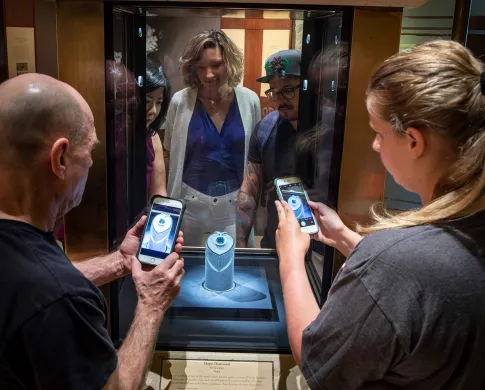
Butterfly Pavilion
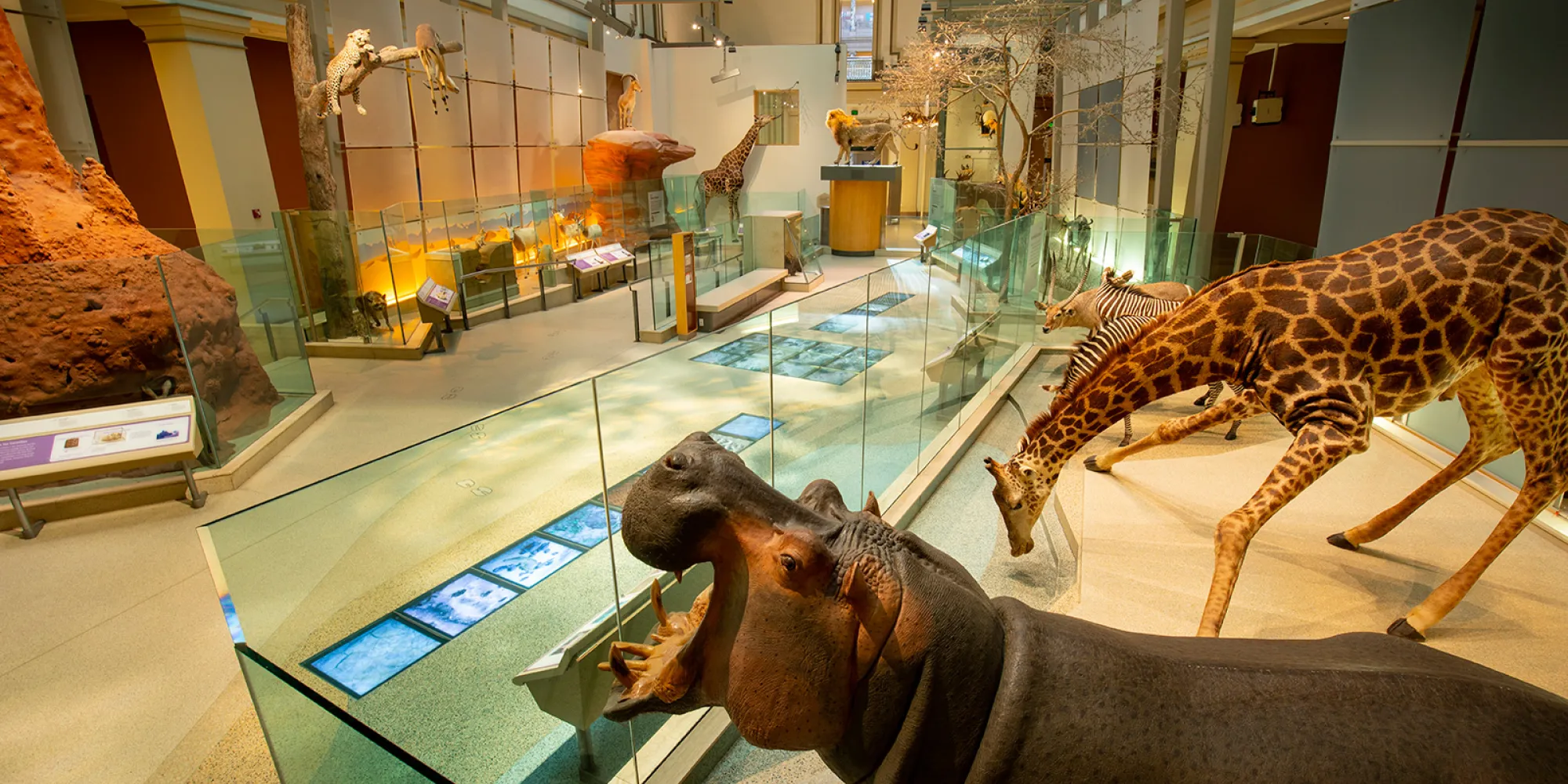
Today at the Museum

Visit the Museum from Home
Additional resources.
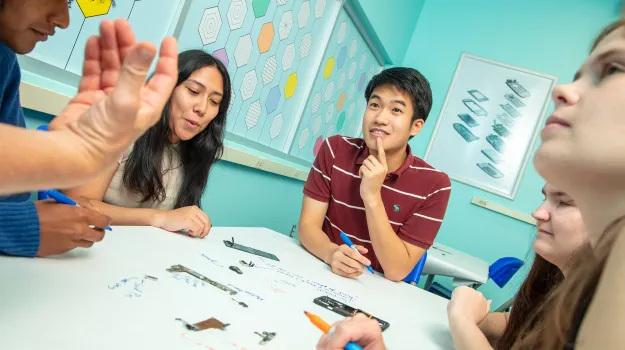
Download Museum Map
Navigate your way around all three floors of the museum.
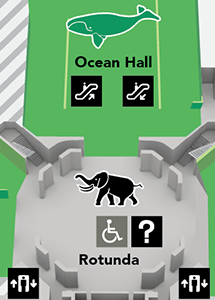
- Smithsonian Institution
- Terms of Use
- Privacy Policy
- Host an Event
Smithsonian Voices
From the Smithsonian Museums

SMITHSONIAN ASSOCIATES
An Evening With Author Erik Larson and More Programs in May
Online and in person, Smithsonian Associates offers classes, discussions and lectures for curious minds
Lauren Lyons
:focal(1363x746:1364x747)/https://tf-cmsv2-smithsonianmag-media.s3.amazonaws.com/filer_public/b6/5e/b65ea26e-07f4-4c27-81d7-715de1ce7859/erik_larson_author_photo_-_credit_nina_subin.jpg)
Smithsonian Associates offers innovative, engaging learning experiences for people of all ages. Hundreds of online and in-person lectures, seminars, performances, hands-on studio arts classes, one-of-a-kind study tours and children’s programs are offered annually. To view the Smithsonian Associates digital program guide, visit smithsonianassociates.org .
Wednesday, May 1
Lincoln: The Months Before Sumter : Drawing on his new book The Demon of Unrest , Erik Larson examines the chaotic months between Lincoln’s election in November 1860 and the Confederacy’s shelling of Sumter—a period marked by tragic errors and miscommunications, enflamed egos and craven ambitions, personal tragedies and betrayals. Using information from diaries, secret communiques, slave ledgers and plantation records, Larson discusses the five months that led to the start of the Civil War—a slow-burning crisis that finally tore a deeply divided nation in two. This program will be held in person at the Smithsonian’s National Museum of Natural History at 6:45 p.m. ET. A pre-signed copy of the book is included in the ticket price. $50
Thursday, May 2
Making Democracy Count: Math’s Influential Role in Voting and Representation: Are you feeling like it’s impossible to repair our ailing democracy and the mechanisms that power it? Math holds the key to creating an infrastructure that benefits everyone, says math professor Ismar Volić. Presenting mathematical thinking as an objective, nonpartisan framework, Volic explains why the current voting system stifles political diversity and the Electoral College must be rethought—and suggests what can work better. This program will be held on Zoom at 6:30 p.m. ET. $20-$25
Saturday, May 4
Great Houses of Scotland and Their Treasures: The architecture and interiors of Scotland’s finest historic houses uniquely reflect the country’s heritage and culture. In a richly illustrated day-long journey into history, cultural historian Lorella Brocklesby explores more than 400 years of splendor from fortified 16th-century tower houses and palaces of Baroque extravagance to elegant 18th-century residences and exuberant revival styles of the Victorian period. Participants enrolled in the Smithsonian World History Certificate program will earn 1 credit. This program will be held on Zoom from 10 a.m. to 4 p.m. ET. $80-$90
/https://tf-cmsv2-smithsonianmag-media.s3.amazonaws.com/filer_public/2d/90/2d9091a5-e736-48b1-b52c-a0f2ba278652/cyanotype_wkshp_sammie_correa.jpeg)
Hand-On History of Photography: Cyanotypes: Delve into the history of cyanotypes, a photographic printing process that produces a cyan-blue and white print, and create your own cyanotype in this unique studio arts class. Participants enrolled in the Smithsonian World History Certificate program will earn 1/2 credit. This 2-session program will be held on Zoom at 6:45 p.m. ET. The second session will take place on May 11. $85-$105
Monday, May 6
“Bridgerton” and the Real World of Regency London: Society in Regency London was ruled by a few hundred wealthy families whose strict codes of conduct, fashion and social customs dictated who and what was acceptable. Fans of the “Bridgerton” series know them as the Ton, celebrities of the day who engaged in what was described as "a business of pleasure." Historian Julie Taddeo examines the tightly circumscribed lives of these fashionable men and women and how the Ton was eventually forced to welcome non-aristocratic members into their ranks or risk dying off. This program will be held on Zoom at 6:45 p.m. ET. $20-$25
Wednesday, May 8
Susan Page on Barbara Walters: Television’s Rulebreaker: Barbara Walters was a force from the time TV was exploding on the American scene in the 1960s to its waning dominance in a new world of streaming services and social media. Drawing from her new biography of Walters, Susan Page, Washington bureau chief of USA Today , examines the woman behind the legacy—one whose personal demons fueled an ambition that broke all the rules and finally gave women a permanent place on the air. This program will be held on Zoom at 6:45 p.m. ET. $25-$30
Thursday, May 9
Captivating Spring Gardens: The Scott Arboretum and the Mt. Cuba Center: The Philadelphia region boasts the title of America's Garden Capital, and with more public gardens than anywhere else in the country, it’s a well-deserved one. Spend a day with horticulturist Chelsea Mahaffey exploring two captivating green spaces in the area— the Scott Arboretum on the Swarthmore College campus and the Brandywine Valley’s Mt. Cuba Center—and gather new ideas for your own home garden. This all-day study tour will depart at 8 a.m. from the Mayflower Hotel at 1127 Connecticut Ave N.W. in Washington D.C. $195-$245
Molds, Mushrooms, and Medicines : From beneficial yeasts that aid digestion to toxic molds that cause disease, we are constantly navigating a world filled with fungi. Drawing on the latest advances in mycology, biologist Nicholas P. Money explores the amazing ways fungi interact with our bodies, showing how our health and well-being depend on an immense ecosystem of yeasts and molds inside and all around us. This program will be held on Zoom at 6:45 p.m. ET. $20-$25
Language Peeves: Inner Grammandos vs. Inner Wordies: From her perspective as a historian of the English language, linguist, and veteran English professor at the University of Michigan, Anne Curzan examines some common peeves in grammar, tackling such puzzlers as “who vs. whom,” “less vs. fewer,” “based on vs. based off,” and the eternal “between you and I.” She explores how we can reconcile the clash of our inner grammando (who can’t help but judge bits of usage we see and hear) and inner wordie (who loves to play Wordle and make new puns and the like) and offers tools for becoming an even more skilled word watcher. This program will be held on Zoom at 6:30 p.m. ET. $25-$30
Tuesday, May 14
Silk: A World History: Silk, prized for its lightness, luminosity, and beauty is also one of the strongest biological materials known. The technologies it has inspired—from sutures to pharmaceuticals, replacement body parts to holograms—continue to be developed in laboratories around the world. Author Aarathi Prasad outlines the cultural and scientific history of the fabric including its origins, the ancient silk routes, and its future as a powerful resource. This program will be held on Zoom at 12 p.m. ET. $25-$30
Spiritual But Not Religious: Healthy Trend or Crisis of Faith?: Is it possible to be spiritual and not religious at the same time? Self-identification as “SBNR” is a growing trend in the United States and abroad that promotes the de-institutionalization of religion and a kind of spiritual individuation. Comparative religion scholar Graham Schweig analyzes this phenomenon psychologically and theologically by drawing from ancient Eastern and Western wisdom traditions. This program will be held on Zoom at 6:30 p.m. ET. $25-$30
/https://tf-cmsv2-smithsonianmag-media.s3.amazonaws.com/filer_public/a4/cb/a4cb7fd0-6505-4442-856b-7283d513691b/rock_creek_park_-boulder_bridge_-__washington_dc-small.jpg)
Thursday, May 16
Urban Oasis: A History of Rock Creek Park: In 1890 more than 2,000 acres winding through Northwest Washington were set aside as a refuge for wildlife and an escape for District residents designed by the Olmstead Brothers: Rock Creek Park. Carolyn Muraskin surveys familiar parts of the landscape, including the Smithsonian’s National Zoo, as well as lesser-known landmarks, memorials, ruins, and other remnants of Rock Creek’s past. This program will be held on Zoom at 7 p.m. ET. $25-$30
Friday, May 17
It's About Time: Organizing the Calendar, Times Zones, and the Clock: Once upon a time, humans could mostly ignore the clock, but the Industrial Age and its expanding system of railroads forced societies to devise a system of global timekeeping. Journalist Adam Tanner traces the intriguing evolution of the human invention of time—the source of today’s crazy quilt of different times across the globe, which developed after surprisingly heated international debate—as well as the time-focused controversies that continue today. This program will be held on Zoom at 12 p.m. ET. $25-$30
Sunday, May 19
Cyanotype Workshop : The cyanotype photographic method uses the sun to expose UV-light–sensitive chemicals in order to create rich, deep blue prints. Learn a short history of cyanotypes and how to use the cyanotype chemicals alongside objects from nature or your home, then put basic techniques to work to create prints. This weekend workshop will take place in person at the Smithsonian’s Ripley Center from 11 a.m. to 1:30 p.m. ET $70-$85
Wednesday, May 22
Propagating Orchids: Join an orchid care expert for a fun, informative evening exploring a beautiful, and sometimes challenging to grow, favorite household plant. This program will be held on Zoom at 6:30 p.m. ET. $50-$65
Wednesday, May 29
Hog Island: Maine’s Showcase of Nature : Tucked away along coastal Maine, Hog Island is the home of a National Audubon Society camp that has been operation since 1936. Isolated from the outside world and filled with both pristine forest and coastal habitats, the surrounding Muscongus Bay teems with terns, bald eagles, common eiders, and seals. Naturalist Matt Felperin shares his experiences at the camp, displays striking wildlife photos, and reveals why Hog Island should be on your bucket list of nature-education programs. This program will be held on Zoom at 7 p.m. ET. $25-$30
Thursday, May 30
Adventures in the Archives—and Beyond: An Historian’s Unconventional Research: For historians like Megan Kate Nelson, the “archive,” usually a library, university, museum, or historical society collection, is a sacred place. But what happens when these sources don’t contain the answers they seek? Nelson unfolds three research adventures that led her to places beyond the traditional archives—including a mountain pass in New Mexico—during her preparation for The Three-Cornered War , a book about the Civil War in the desert Southwest. This program will be held on Zoom at 12 p.m. ET. $25-$30
Anna May Wong: Hollywood’s Unsung Heroine : The taboo-smashing star Anna May Wong challenged Hollywood at its own game by speaking out about the industry’s blatant racism. Unhappy with being typecast as a China doll or dragon lady, she used her international fame to reshape Asian American representation in film. Biographer Katie Gee Salisbury discusses Wong’s career as a groundbreaking artist, bringing an unsung heroine to light and reclaiming her place in cinema history. This program will be held on Zoom at 6:45 p.m. ET. $20-$25
To view the Smithsonian Associates digital program guide, visit smithsonianassociates.org .
Lauren Lyons | READ MORE
Lauren Lyons is a public affairs specialist at Smithsonian Associates.

IMAGES
VIDEO
COMMENTS
September 30, 2014. Earth is a planet defined by change, swinging through periods of intense heat and deep freeze even as oceans and continents are reshaped by the actions of plate tectonics. This ...
Deep Time starts at the very beginning—4.6-billion-years ago. But it ends in the future. Along the way, visitors will travel through ancient ecosystems, experience the evolution of plant and animal life, and get up close with some 700 specimens, including an Alaskan palm tree, early insects, reptiles and mammals, and dramatically posed giants like Tyrannosaurus rex, Diplodocus and the woolly ...
In the David H. Koch Hall of Fossils, approximately 700 fossil specimens, many never before on display, tell the story of Earth's deep past and tracks the history of life on this planet. The 31,000-square-foot exhibition, structured as a journey through time, reveals how this 3.7 billion-year history is connected to the present and shapes the ...
Overview On June 8, the Smithsonian's National Museum of Natural History will open "The David H. Koch Hall of Fossils—Deep Time," an immersive 31,000-square-foot dinosaur and fossil hall. The exhibition explores Earth's 3.7 billion-year history, highlighting how our distant past is connected to the present and informs our future. Visitors will travel through ancient ecosystems ...
The Smithsonian National Museum of Natural History 's David H. Koch Hall of Fossils is a $110 million, 31,000-square-foot exhibit with a theme of Deep Time, borrowed from a scientific phrase that illustrates how Earth's history has played out over billions of years - what we think of as history is just a small fraction of our planet's past.
June 8, 2019 - Permanent. In its new pose devouring a Triceratops, the Nation's T. rex is the centerpiece of the David H. Koch Hall of Fossils—Deep Time. This exhibition showcases the museum's unrivaled collection of 46 million fossils, presents the most up-to-date scientific research on how life on Earth has evolved, and presents the ...
Humans are now altering the life-support systems of the entire planet, marking a unique moment in Earth's 4.56-billion-year history. It is essential that we understand how global systems change over time and develop sustain-able strategies for the management of natural systems. The Museum has the largest fossil collection in the world with 40 ...
Virtual Tour. Current Exhibits. Deep Time Enhanced Virtual Tour Fossil List. This is select list of fossils and other assets featured on the improved virtual tour of the David H. Koch Hall of Fossils (Deep Time) that has been enhanced with close-ups of educational content from the exhibit: fossils, videos, murals, and text panels.
When the Smithsonian's new Hall of Fossils—Deep Time exhibition opens its doors on June 8, hundreds of species will spring to simulated life. The 700 fossil specimens that roam the hall cover ...
The David H. Koch Hall of Fossils: Deep Time. ERROR: Adobe Flashplayer or. HTML5 Browser with WebGL or CSS3D support required! Welcome to the 4th revision of the Smithsonian's Virtual Tour of the Natural History Museum. This is a live work in progress focused on turning the tours into STEM courseware.
The "David H. Koch Hall of Fossils - Deep Time" exhibit opened on June 8, 2019 Smithsonian Institution Even after opening weekend, many of the project leaders still meander into the hall.
By Carolyn Gramling. June 4, 2019 at 12:17 pm. After five years, the Smithsonian National Museum of Natural History in Washington, D.C., is finally reopening its dinosaur hall on June 8. Visitors ...
We invite you to join Skip in finding your place in Deep Time and becoming a part of this ambitious new project.. Donate; To discuss philanthropic opportunities within the Fossil Hall, contact Laura Blackwelder at 202.633.0236 or [email protected].. To become a Leadership Circle member, or learn more about Family memberships, contact Sara Cronan at 202.633.0818 or [email protected].
When Whales Walked: Journeys In Deep Time | Smithsonian Channel. TV-PG. Special. Documentary. 1h 27m. This evolutionary journey asks why whales are so big, why elephant tusks are shrinking, and why birds are everywhere....
Dropbox password: deep time. The Smithsonian's National Museum of Natural History will reopen its dinosaur and fossil hall Saturday, June 8. The 31,000-square-foot exhibition will feature an authentic Tyrannosaurus rex skeleton alongside more than 700 other fossil specimens, including mammals, reptiles, plants and insects—some never before ...
By reframing the Smithsonian's extensive fossil collection with the concept of deep time, the museum aimed to draw connections between geological history and contemporary climate change. As such, it engages with the challenge of history in the Anthropocene , a challenge that Dipesh Chakrabarty described in his oft-cited article "The Climate ...
We are thrilled to present Active Journeys, a new collection of culture-rich trips developed for travelers who seek to explore the world more actively. Smithsonian Journeys and Ponant. Cruises feature Smithsonian-crafted cultural experiences onboard and on land. Smithsonian Student Travel. Immersive Summer Programs for High School Students!
The "Deep Time" project is the largest and most complex renovation in the museum's history. All of the current fossil exhibitions, including Life in the Ancient Seas, Dinosaurs and Ice Ages ...
Dr Victoria Whitworth grew up in Kenya, where she developed a passion for the deep past and the natural world. At the universities of Oxford and York she studied medieval literature, art, and archaeology, and in between degrees she worked and travelled in Greece, and qualified as a Blue Badge Guide with the London Tourist Board. Her doctorate was on the origin of medieval Christian ideas of ...
The Deep Time Audio Description App use the accessibility features native to a visitor's phone to explore the new Fossil Hall through a self-guided tour. Much of the Fossil Hall exhibition has been summarized into a manageable size and integrated with visual descriptions of key content, videos, touchscreen interactives, and iconic specimens.
The app presents "Deep Time" through a combination of descriptions of the displays and the corresponding scientific information. Users aren't confined to a preset tour with a fixed number of ...
A 16-Million-Year-Old Tree Tells a Deep Story of the Passage of Time . To explain the exceedingly long life of the planet, the Smithsonian's new fossil hall designers began with this arboreal wonder
Urban Oasis: A History of Rock Creek Park: In 1890 more than 2,000 acres winding through Northwest Washington were set aside as a refuge for wildlife and an escape for District residents designed ...